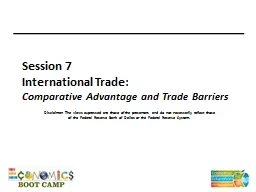

Comparative Advantage and Trade Barriers Disclaimer The views expressed are those of the presenters and do not necessarily reflect those of the Federal Reserve Bank of Dallas or the Federal Reserve System ID: 727057
Download Presentation The PPT/PDF document "Session 7 International Trade:" is the property of its rightful owner. Permission is granted to download and print the materials on this web site for personal, non-commercial use only, and to display it on your personal computer provided you do not modify the materials and that you retain all copyright notices contained in the materials. By downloading content from our website, you accept the terms of this agreement.
Slide1
Session 7International Trade:Comparative Advantage and Trade Barriers
Disclaimer: The views expressed are those of the presenters and do not necessarily reflect those of the Federal Reserve Bank of Dallas or the Federal Reserve System.Slide2
StandardsSSEIN1 The student will explain why individuals, businesses, and
governments trade
goods
and services
.
a. Define
and distinguish between absolute advantage and
comparative advantage
.
b. Explain
that most trade takes place because of comparative advantage in
the production
of
a good
or service.
c. Explain
the difference between balance of trade and balance of
payments.
SSEIN2
The student will explain why countries sometimes erect trade
barriers and sometimes advocate
free trade.
a. Define
trade barriers as tariffs, quotas, embargoes, standards, and subsidies.
b. Identify
costs and benefits of trade barriers over time.
c. List
specific examples of trade barriers.
d. List
specific examples of trading
blocks
such as the EU, NAFTA, and ASEAN.
e. Evaluate
arguments for and against free trade.Slide3
Teaching the TermsAbsolute advantage
Comparative advantage
Opportunity cost
Factor endowments
Imports
Exports
Tariffs
Quotas
SubsidiesSlide4
Why trade?All trade is voluntaryPeople trade because they believe that they will be better off by tradingSlide5
Absolute Advantage“The natural advantages which one country has over another in producing particular commodities are sometimes so great that it is acknowledged by all the world to be in vain to struggle with them.”
Adam Smith in
“Wealth of Nations” Book IV, Chapter 2Slide6
Comparative AdvantageDavid Ricardo extended the ideas of Adam Smith
Nations could benefit from trade based on comparative advantage, not just absolute advantage
Comparative advantage
refers to a country’s ability to produce a good at a lower opportunity cost than another countrySlide7
Sources of Comparative AdvantageDifferences in technologyDifferences in climate
Differences in factor endowments
Factors of production – land, labor and capital
Factor intensity – the factor that is used intensively in production
Heckscher-Ohlin modelSlide8
Imagine an island with only two trees but lots of boats. The islanders produce two goods, coconuts and fish.
A nearby island has many trees, but it has very few boats.
Initially, there is no contact between the islands. However, a new navigational device will soon allow shipments between the islands. What will happen?Slide9
Only two trees →
expensive domestic
coconuts before trade
Imported foreign coconuts are cheap
Domestic price of coconuts
↓
with trade
Lots of boats
→
cheap domestic fish before trade
New export markets for fish increases demand
Domestic price of fish
↑
with tradeSlide10
Who cares about the price of coconuts?People who own trees (land)
People who climb trees (labor)
Who cares about the price of fish?
People who own boats (capital)
People who sail and fish (labor)Slide11
Who could object?Slide12
CSlide13
Who could object?Slide14
CSlide15
Who could object?The total gains from specialization and trade are greater than the lossesBut those gains do not necessarily go to the parties who lost welfare because of the trade
The challenge becomes the willingness of “winners” to compensate “losers”Slide16
Barriers to TradeSlide17
TariffTax on imported goods or services
Reasons for tariffs
Raise tax revenues
Reduce consumption of the imported good or service
Effect – Price of import rises, “cheaper” domestic goods become more attractiveSlide18
QuotaLimits the amount of an imported good allowed into the country
Supply is decreased and price increases
Voluntary Export Restrictions
(VER’s) are similarSlide19
EmbargoStopping all trade with a particular countryNot always the most effective
Economic means to political change
Cuba and Cuban cigarsSlide20
SanctionsGovernment restrictions (limits) on trade
Limits on what can be traded and what cannot
- Russia and Crimea Slide21
Export SubsidyGovernment financial assistance to a firm that allows a firm to sell its product at a reduced price
Benefits and harms
Consumers (both at home and abroad) benefit from lower prices
Foreign producers are harmed because of lower world prices
Taxpayers in the producing country pay the subsidySlide22
Product StandardsA type of “hidden” trade barrier
Types of standards
Product safety
Content
PackagingSlide23
Trade AgreementsGeneral Agreement on Trade and Tariffs (GATT) and World Trade Organization (WTO)
Regional trade agreementsSlide24
GATT“Provisional” agreement (1948 – 1994)Dramatic tariff reductions were negotiated in a series of trade rounds
Grew from 23 to 123 countriesSlide25
WTOWTO created in the Uruguay trade round Established in Geneva in 1995
153 member countries
GATT was updated and still forms the legal framework for WTO negotiations on the goods tradeSlide26
What is the WTO?A negotiating forumA set of rules (international agreements)
GATT
GATS (General Agreement on Trade in Services)
TRIPS (Agreement on Trade-Related Aspects of Intellectual Property Rights)
A place to settle trade disputesSlide27
Regional Trade AgreementsExamples include
North American Free Trade Agreement
Association of Southeast Asian Nations
Common Market of the South (MERCOSUR)
European Union
Regional agreements have been praised and criticizedSlide28
Questions?